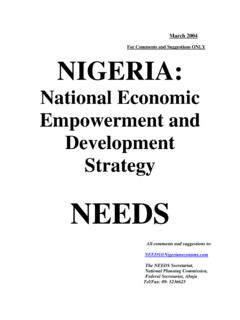Transcription of The Impact of Infrastructure on Trade and Economic …
1 ADBI Working Paper Series The Impact of Infrastructure on Trade and Economic Growth in Selected Economies in Asia Normaz Wana Ismail Jamilah Mohd Mahyideen No. 553 December 2015 Asian Development Bank Institute The Working Paper series is a continuation of the formerly named Discussion Paper series; the numbering of the papers continued without interruption or change. ADBI s working papers reflect initial ideas on a topic and are posted online for discussion. ADBI encourages readers to post their comments on the main page for each working paper (given in the citation below).
2 Some working papers may develop into other forms of publication. Suggested citation: Ismail, N. W., and J. M. Mahyideen. 2015. The Impact of Infrastructure on Trade and Economic Growth in Selected Economies in Asia. ADBI Working Paper 553. Tokyo: Asian Development Bank Institute. Available: Please contact the authors for information about this paper. Email: Normaz Wana Ismail is an associate professor of economics and management at Universiti Putra Malaysia. Jamilah Mohd Mahyideen is a lecturer at Universiti Teknologi MARA. The views expressed in this paper are the views of the authors and do not necessarily reflect the views or policies of ADBI, ADB, its Board of Directors, or the governments they represent.
3 ADBI does not guarantee the accuracy of the data included in this paper and accepts no responsibility for any consequences of their use. Terminology used may not necessarily be consistent with ADB official terms. Working papers are subject to formal revision and correction before they are finalized and considered published. Asian Development Bank Institute Kasumigaseki Building 8F 3-2-5 Kasumigaseki, Chiyoda-ku Tokyo 100-6008, Japan Tel.: +81-3-3593-5500 Fax: +81-3-3593-5571 URL: E-mail: 2015 Asian Development Bank Institute ADBI Working Paper 553 Ismail and Mahyideen Abstract Infrastructure plays a key role in facilitating Trade , especially since recent Trade liberalization in Asia has resulted in significant tariff reductions.
4 This study quantifies the impacts of both hard and soft Infrastructure on Trade volume for exporters and importers in the region as well as on various Economic growth indicators. Results demonstrate that improvements in transport Infrastructure ( , the road density network, air transport, railways, ports, and logistics) have resulted in increased Trade flows. Information and communications technology (ICT) Infrastructure has also enhanced Trade , as the numbers of telephone lines, mobile phones, broadband access, internet users, and secure internet servers are found to have positive Trade effects for both exporters and importers in Asia.
5 Thus, although more attention has traditionally been given to hard Infrastructure , the Impact of soft Infrastructure on Trade flows must also be more thoroughly examined. JEL Classification: O18, O53, R53 ADBI Working Paper 553 Ismail and Mahyideen Contents 1. Background .. 3 2. Infrastructure Development in Asia .. 6 3. Literature Review .. 8 Infrastructure and Trade .. 8 Infrastructure and Growth .. 10 4. Empirical 12 Impact of Infrastructure on Trade .. 12 Impact of Infrastructure on Economic Growth.
6 14 5. Results and Discussion .. 16 Transport Infrastructure and Trade Flows .. 16 Information and Communication Technology Infrastructure and Trade Flows .. 18 Soft Infrastructure and Trade Flows .. 21 Effects of Infrastructure on Agricultural and Manufacturing Exports .. 21 Impact of Infrastructure on Economic Growth .. 24 6. Summary and Conclusion .. 26 References .. 28 ADBI Working Paper 553 Ismail and Mahyideen 3 1. BACKGROUND Many economies in Asia have exhibited a bandwagon effect by signing Trade integration agreements and lowering tariff barriers to increase Trade .
7 For example, members of the Association of Southeast Asian Nations (ASEAN) now enjoy tariff import rates as low as 0%, and ASEAN has also recently expanded to include the People s Republic of China (PRC), India, Japan, and Republic of Korea. Extensive evidence has also shown that improving international transport fosters international Trade , such as through tariff liberalization (Baier and Bergstrand 2007; Andriamananjara et al. 2004). Facilitating Trade is necessary to minimize the cost of Trade and to provide access to markets.
8 In Asia, the Trade pattern has also recently shifted from finished products to intermediate and processing products. Economies that specialize in different tasks have added value to parts and components, which are imported for processing and assembly into semi-finished or finished products and then re-exported to the global supply chain before reaching end-users. Table 1 shows the performance of exports and imports in Asia. The PRC, India, Singapore, Thailand, and Viet Nam increased their export gross domestic product (GDP) ratio from to between 2000 and 2012.
9 The agricultural export export ratio in Viet Nam further increased by (from in 2000 to in 2012), followed by Thailand ( ), Philippines ( ), India ( ), and Indonesia ( ). Intra-Asian Trade also increased by more 200% from 2003 to 2013. With such increased Trade , Trade cost has become a major concern. According to Anderson and Van Wincoop (2003), Trade cost was estimated at 170% (in terms of ad-valorem equivalent) for industrialized countries. The major categories of Trade cost were transport (21%), border-related Trade barriers (44%), and retail and wholesale distribution (55%).
10 However, Trade cost is even larger in developing countries, many of which are found in Asia; thus, Infrastructure is relevant to Trade facilitation, particularly in minimizing Trade cost and further enhancing competitiveness. Infrastructure is vital to Economic development, as it is key to achieving higher and stable Economic growth. Although most economies in Asia have already developed their basic Infrastructure , the focus of development is usually on the quantity rather than the quality. According to World Economic Forum (2014), well-developed Infrastructure not only reduces the distance between regions but also integrates national markets and connects them at low costs to other economies.

















